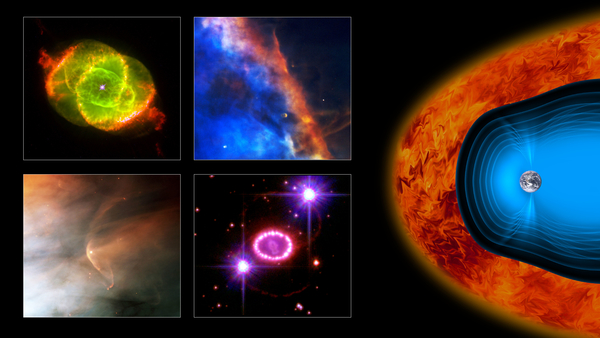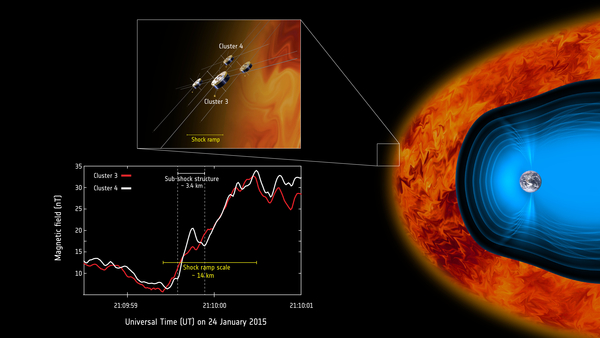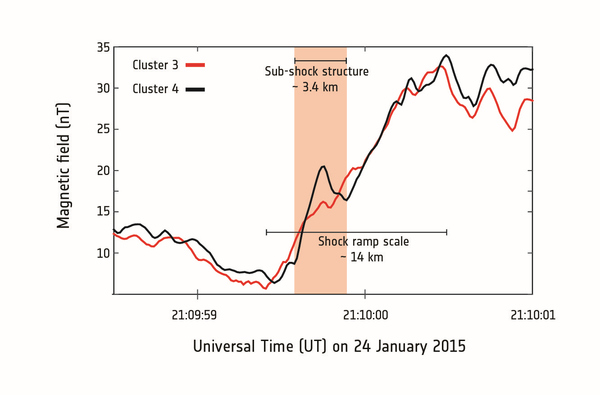Cluster reveals inner workings of Earth's cosmic particle accelerator
27 February 2019
Using unprecedented in-situ data from ESA's Cluster mission, scientists have shed light on the ever-changing nature of Earth's shield against cosmic radiation, its bow shock, revealing how this particle accelerator transfers and redistributes energy throughout space. |
| Shocks in the Universe. Credit: ESA (Earth magnetosphere illustration); NASA, ESA/Hubble (insets; click here for details) |
The new study used observations from two of the Cluster mission's four spacecraft, which flew in tight formation through Earth's bow shock, sitting just 7 kilometres apart.
The data were gathered on 24 January 2015 at a distance of 90 000 kilometres from Earth, roughly a quarter of the way to the Moon, and reveal properties of the bow shock that were previously unclear due to the lack of such closely spaced in-situ measurements.
When a supersonic flow encounters an obstacle, a shock forms. This is seen often in the Universe around stars, supernova remnants, comets, and planets – including our own. Shocks are known to be very efficient particle accelerators, and potentially responsible for creating some of the most energetic particles in the Universe.
The shock around the Earth, known as the bow shock, is our first line of defence against particles flooding inwards from the cosmos, and our nearest test-bed to study the dynamics of plasma shocks. It exists due to the high, supersonic speeds of solar wind particles, which create a phenomenon somewhat akin to the shock wave formed when a plane breaks the sound speed barrier.
The new study, published today in Science Advances, reveals the mechanisms at play when this shock transfers energy from one type to another.
"Earth's bow shock is a natural and ideal shock laboratory," says lead author Andrew Dimmock of the Swedish Institute of Space Physics in Uppsala, Sweden.
"Thanks to missions like Cluster, we are able to place multiple spacecraft within and around it, covering scales from hundreds to only a few kilometres.
"This means we can pick apart how the shock changes in space and over time, something that's crucial when characterising a shock of this type."
 |
| Cluster measuring substructures in Earth's bow. Credit: ESA; Data: A. Dimmock et al. (2019) |
There are several types of shock, defined by the ways in which they transfer kinetic energy into other kinds of energy. In Earth's atmosphere, kinetic energy is transformed into heat as particles collide with one another – but the vast distances at play at our planet's bow shock mean that particle collisions cannot play such a role in energy transfer there, as they are simply too far apart.
This type of shock is thus known as a collisionless shock. Such shocks can exist across a vast range of scales, from millimetres up to the size of a galaxy cluster, and instead transfer energy via processes involving plasma waves and electric and magnetic fields.
"As well as being collisionless, Earth's bow shock can also be non-stationary," adds co-author Michael Balikhin of the University of Sheffield, UK.
"In a way, it behaves like a wave in the sea: as a wave approaches the beach, it seems to grow in size as the depth decreases, until it breaks – this is because the crest of the wave moves faster than the trough, causing it to fold over and break.
"This kind of 'breaking' occurs for waves of plasma, too, although the physics is somewhat more complicated."
To investigate in detail the physical scales at which this wave breaking is initiated – something which was previously unknown – the researchers solicited a special campaign in which two of the four Cluster probes were moved to an unprecedentedly close separation of less than 7 km, gathering high-resolution data from within the shock itself.
Analysing the data, the team found that the measurements of the magnetic field obtained by the two Cluster spacecraft differed significantly. This direct evidence that small-scale magnetic field structures exist within the broader extent of the bow shock indicate that they are key in facilitating the breaking of plasma waves, and thus the transfer of energy, in this portion of the magnetosphere.
 |
| Substructures in Earth's bow shock. Credit: A. Dimmock et al. (2019) |
With sizes of a few kilometres, similar to the scales at which electrons rotate around the magnetic field lines, these structures are located in a particularly thin and variable part of the shock, where the properties of the constituent plasma and surrounding fields can change most drastically.
"This part of the bow shock is known as the shock ramp, and can be as thin as a few kilometres – a finding that was also based on Cluster data a few years back," says co-author Philippe Escoubet, who is also ESA project scientist for the Cluster mission.
Launched in 2000, Cluster's four spacecraft fly in formation around the Earth, making it the first space mission able to study, in three dimensions, the physical processes occurring within and in the near vicinity of the Earth's magnetic environment.
"This kind of study really shows the importance of Cluster as a mission," adds Escoubet. "By achieving incredibly small spacecraft separations – seven kilometers as used in this study and even smaller, down to just three kilometres – Cluster is allowing us to probe our planet's magnetic environment at the smallest scales ever achieved.
"This advances our understanding of Earth's bow shock and how it acts as a giant particle accelerator – something that is key in our knowledge of the high-energy Universe."
Notes for editors
"Direct evidence of nonstationary collisionless shocks in space plasmas" by A. Dimmock et al. is published in Science Advances.
Cluster is composed of four identical spacecraft orbiting the Earth in a pyramidal configuration, along a nominal polar orbit of 4 × 19.6 Earth radii (1 Earth radius = 6380 km). Cluster's payload consists of state-of-the-art plasma instrumentation to measure electric and magnetic fields over a wide frequency range, and key physical parameters characterizing electrons and ions from energies of nearly 0 eV to a few MeV. The science operations are coordinated by the Joint Science Operations Centre (JSOC), at the Rutherford Appleton Laboratory, United Kingdom, and implemented by ESA's European Space Operations Centre (ESOC), in Darmstadt, Germany.
For more information please contact
Andrew Dimmock
Swedish Institute of Space Physics
Uppsala, Sweden
Email: andrew.dimmock![]() irfu.se
irfu.se
Michael Balikhin
University of Sheffield
Sheffield, United Kingdom
Email: m.balikhin![]() sheffield.ac.uk
sheffield.ac.uk
Philippe Escoubet
Cluster Project Scientist
European Space Agency
Email: Philippe.Escoubet![]() esa.int
esa.int



